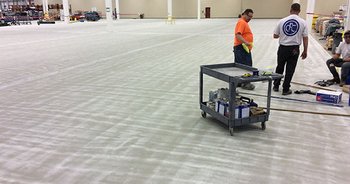
Vapor Barrier Coatings for Concrete
Protect your facility from moisture problems
Have you noticed excess humidity or damp spots on the floor in your warehouse, plant or commercial facility? High levels of moisture can cause a host of problems, including:
- mold growth
- product damage
- equipment failure
- floor coating blistering and peeling
If you’ve eliminated the possibility of plumbing or roofing leaks, and you’ve controlled for climate-caused humidity, then it may be that your concrete floor is the culprit.
What causes vapor problems in concrete?
Though it feels extremely solid, concrete is actually a porous substance that allows gasses to pass through it. When the ground below your building is especially damp, the excess water vapor will travel up through the floor into your facility.
Alternatively, the water vapor may come from the concrete itself. Water is one of the main elements added to concrete during the curing process, and it may take up to a year for the concrete to cure completely. This does not mean that all moisture is out of the concrete, as moisture may still be passing from the ground through your concrete slab.
How vapor barrier coatings protect flooring
If the excess water vapor isn’t dealt with before laying down another type of flooring over the concrete, the damage to your facility can multiply. Unchecked moisture can damage flooring materials such as hardwood, and encourage the growth of mold underneath carpet.
If you install a moisture vapor resistant coating, you can block the water vapor and resist the reaction of corrosive PH levels that can destroy the coating’s bond with the concrete, causing it to bubble, blister or peel.
Only a professional-strength vapor barrier coating can completely block moisture from rising through the floor. When installed under other coatings or flooring materials, it prevents adhesion failures and protects the floor from other damage.
Breathable epoxies
Another option for moisture-prone concrete is a breathable epoxy, which is actually more permeable than typical epoxy and is designed to increase the amount of moisture vapor passing through without damaging the coating’s bond. This is a better choice for fast-track projects in which a coating must be applied to a new and damp concrete slab, even if it’s only had a few days to cure.
Important preparation steps
No two concrete slabs are completely alike, and moisture affects each slightly differently—so be sure to have a professional moisture test done before selecting a vapor barrier coating.
You’ll need to understand exactly what issues you’re dealing with, or you may end up wasting your efforts on the wrong formula and see the same problems repeat themselves. It pays to get a professional opinion first!
In the next section, we’ll walk you through other preparation steps that are important in any floor coating installation.
Let’s get down to business.
One quick form submission gets the ball rolling. . .

